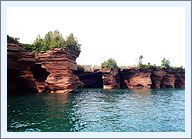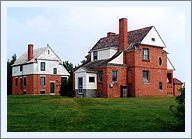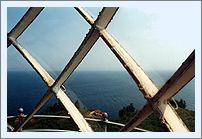|
Historical Information

Devils Island is the northernmost island on the western edge of
the Apostles Group, and represented an important turning point for both
east and westbound vessels coasting along Superior's southern shore.
With the opening of the first lock at Sault Ste Marie in 1855, maritime
traffic along Superior's south shore increased dramatically, and while
Eagle Harbor Light had been established 123 miles to the east to guide
vessels around the Keweenaw in 1851, and Minnesota Point was lighted to
mark the entrance into the twin ports of Duluth/Superior 72 miles to the
west in 1858, this important navigational landmark remained unlighted
for more than thirty years.
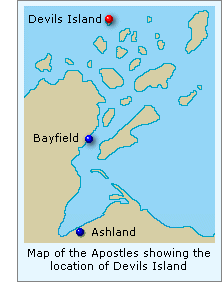 The Lighthouse Board took up the call
of mariners, requesting an appropriation of $15,000 for the
establishment of a station at Devils Island in 1888, and while Congress
enacted legislation for the establishment of the station, they neglected
to follow-up with the requested appropriation, and without the necessary
funding, work on the station could not begin. After the Board reiterated
the request for funding in its 1889 annual report, Congress responded
with the requested funds on March 2 of that same year, and the Eleventh
District Engineer dispatched a survey crew to the island to select a
site and to begin the process of obtaining clear title. The Lighthouse Board took up the call
of mariners, requesting an appropriation of $15,000 for the
establishment of a station at Devils Island in 1888, and while Congress
enacted legislation for the establishment of the station, they neglected
to follow-up with the requested appropriation, and without the necessary
funding, work on the station could not begin. After the Board reiterated
the request for funding in its 1889 annual report, Congress responded
with the requested funds on March 2 of that same year, and the Eleventh
District Engineer dispatched a survey crew to the island to select a
site and to begin the process of obtaining clear title.
While awaiting for matter of title to
be decided in the Wisconsin courts in 1890, Eleventh District Engineer
Major William Ludlow determined that the planned station would benefit
greatly from the incorporation of a steam-powered fog signal, and
without having included the cost of such a system in the original
proposal, recommended that an additional $5,000 be appropriated for the
new station. Congress quickly approved the additional money on March 2,
bringing the total amount of the Devils Island appropriation to $20,000.
The importance placed on this new station was evidenced by the fact that
the plans called-out that it be outfitted with a flashing Third Order
lens, an order reserved for only the most critical aids to navigation on
the Great Lakes. In fact, at that time only six Third Order stations
were in operation in the entire Eleventh District, with four of them on
Lake Superior at Whitefish Point, Au Sable Point, Manitou and Outer
Island, another of the 22 islands making up the Apostle Group. However,
after receiving a number of bids for the station's construction in 1891,
the Board realized that it had significantly underestimated the costs
associated with such a remote and inaccessible construction site.
Estimating that the total cost for the station was going to end up
closer to $42,000, the Board beseeched Congress to appropriate an
additional $22,000 to begin construction.
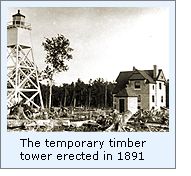 With no progress in reaching an
agreement on the purchase of the island from the current owner,
proceedings were initiated to acquire the property through condemnation.
Realizing that it was highly unlikely that Congress would be forthcoming
with the increased appropriation yet that season, and understanding that
the lighting of Devils Island was critical to maritime interests, work
quickly began on the construction of a temporary tower structure on the
north shore of the island. The temporary tower consisted of a skeleton
timber-framed structure with an enclosed wood-sided watchroom. Standing
24 feet square at the base and 9 feet 6 inches square at the top, the
structure stood approximately 60 feet in height. Outfitted with an
octagonal cast iron lantern containing a fixed red Fourth Order
Fresnel lens,
the light stood at a focal plane of 87 feet by virtue of its location
atop one of the island's cliffs. The Devils Island Light was exhibited
for the first time on the evening of September 30, 1891, its light
visible at a distance of 13 miles across the surface of the lake. With no progress in reaching an
agreement on the purchase of the island from the current owner,
proceedings were initiated to acquire the property through condemnation.
Realizing that it was highly unlikely that Congress would be forthcoming
with the increased appropriation yet that season, and understanding that
the lighting of Devils Island was critical to maritime interests, work
quickly began on the construction of a temporary tower structure on the
north shore of the island. The temporary tower consisted of a skeleton
timber-framed structure with an enclosed wood-sided watchroom. Standing
24 feet square at the base and 9 feet 6 inches square at the top, the
structure stood approximately 60 feet in height. Outfitted with an
octagonal cast iron lantern containing a fixed red Fourth Order
Fresnel lens,
the light stood at a focal plane of 87 feet by virtue of its location
atop one of the island's cliffs. The Devils Island Light was exhibited
for the first time on the evening of September 30, 1891, its light
visible at a distance of 13 miles across the surface of the lake.
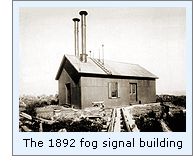 Work began on the island in earnest at
the opening of navigation in 1892, with the construction of a 1½-story
wood-framed outbuilding which would serve as temporary quarters for the
construction crew as they worked through the summer, and by October the
station was virtually complete. A steam-powered hoisting derrick was
constructed to the west of the site to allow supplies to be hoisted up
the cliff and a cellar was blasted in the rock with a 1½-story brick
keepers dwelling constructed atop this foundation. A 100 foot-long
trench was blasted in the rock to allow the connection of a sewage
disposal pipe leading from the station's cellar directly to the lake,
and a landing crib and boat house were constructed at the shore. A pump
house and covered water delivery pipe were built to the fog-signal
building located 500 feet to the northwest of the tower. The fog-signal
building itself was a wood frame structure with the exterior sheathed in
corrugated iron and the interior surfaces sheathed with smooth iron
sheets. The walls were packed with a mixture of sawdust and lime to help
fireproof the structure, and the duplicate 10-inch steam whistles and
boilers were then installed within. The steam whistle controller was
adjusted to ensure that the signal conformed to the predetermined
60-second repeated characteristic, consisting of a 5-second blast
followed by a 10-second silence, 5-second blast and final 40-second
silence. However, without an appropriation for the necessary funds for
the permanent tower and second keeper's dwelling, work on Devils Island
was stopped at the end of the 1892 season of navigation. Work began on the island in earnest at
the opening of navigation in 1892, with the construction of a 1½-story
wood-framed outbuilding which would serve as temporary quarters for the
construction crew as they worked through the summer, and by October the
station was virtually complete. A steam-powered hoisting derrick was
constructed to the west of the site to allow supplies to be hoisted up
the cliff and a cellar was blasted in the rock with a 1½-story brick
keepers dwelling constructed atop this foundation. A 100 foot-long
trench was blasted in the rock to allow the connection of a sewage
disposal pipe leading from the station's cellar directly to the lake,
and a landing crib and boat house were constructed at the shore. A pump
house and covered water delivery pipe were built to the fog-signal
building located 500 feet to the northwest of the tower. The fog-signal
building itself was a wood frame structure with the exterior sheathed in
corrugated iron and the interior surfaces sheathed with smooth iron
sheets. The walls were packed with a mixture of sawdust and lime to help
fireproof the structure, and the duplicate 10-inch steam whistles and
boilers were then installed within. The steam whistle controller was
adjusted to ensure that the signal conformed to the predetermined
60-second repeated characteristic, consisting of a 5-second blast
followed by a 10-second silence, 5-second blast and final 40-second
silence. However, without an appropriation for the necessary funds for
the permanent tower and second keeper's dwelling, work on Devils Island
was stopped at the end of the 1892 season of navigation.
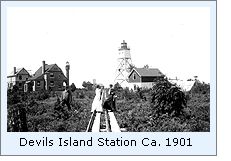 The Lighthouse Board repeated its
request for the funds for completing the station in each of its annual
reports for the following three years, with Congress finally authorizing
the work on February 15, 1895, and following-up with an appropriation
for the necessary funds on March 2. However, the wording of the
appropriation specifically called-out that the appropriation was to be
spent on the construction of the permanent tower, and while the total
amount of the appropriation was sufficient to complete the station,
without written approval to build the keepers dwelling, construction of
the dwelling was out of the question. Congress amended the appropriation
on June 11, 1896, allocating $4,000 of the remaining funds for the
construction of the keepers dwelling. Condemnation proceedings were
finally brought to a close in August, with an award of $1,600 being paid
to the former owner of the island. With the funding sorted-out, Eleventh
District Engineer Major Milton B. Adams advertised bids for the metal
work of the cast iron tower and placed the order for the Third Order
Fresnel lens with Parisian lens manufacturer Henry-Lepaute. A working
party arrived on the island on July 1, 1897 and work began on the second
dwelling, which was built as a duplicate of the first structure, and
laid concrete foundation for the new tower. The Lighthouse Board repeated its
request for the funds for completing the station in each of its annual
reports for the following three years, with Congress finally authorizing
the work on February 15, 1895, and following-up with an appropriation
for the necessary funds on March 2. However, the wording of the
appropriation specifically called-out that the appropriation was to be
spent on the construction of the permanent tower, and while the total
amount of the appropriation was sufficient to complete the station,
without written approval to build the keepers dwelling, construction of
the dwelling was out of the question. Congress amended the appropriation
on June 11, 1896, allocating $4,000 of the remaining funds for the
construction of the keepers dwelling. Condemnation proceedings were
finally brought to a close in August, with an award of $1,600 being paid
to the former owner of the island. With the funding sorted-out, Eleventh
District Engineer Major Milton B. Adams advertised bids for the metal
work of the cast iron tower and placed the order for the Third Order
Fresnel lens with Parisian lens manufacturer Henry-Lepaute. A working
party arrived on the island on July 1, 1897 and work began on the second
dwelling, which was built as a duplicate of the first structure, and
laid concrete foundation for the new tower.
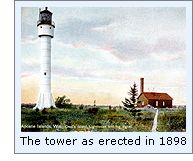 The structural iron work of the tower
was delivered to the Detroit Depot in June of 1898, and after a
successful inspection, was loaded on the tender Amaranth along with a
working party and dispatched to Lake Superior. Arriving at Devils
Island, the work crew extended the boat landing, repaired the boat house
and steam powered derrick, and began erecting the 80 foot tall iron
tower on the foundation laid the previous year. Work on the tower was
completed on October 17th. Consisting of a central cylinder topped by a
circular watch room, the entire structure was reinforced by four iron
buttresses, reinforced with iron lattice work at the flared lower end at
which point they were bolted into the concrete foundation. The watchroom
was outfitted with circular portholes and surmounted by a gallery on
which was centered a circular cast iron lantern with diagonal astragals.
Standing 81 feet from the foundation to the ventilator ball, the entire
structure was given a coat of white paint, with the exception of the
lantern and roof, which were painted black to help differentiate them
from cloudy skies, thereby increasing the towers' effectiveness as a
daymark. Since the new lens had not yet been received from Paris, the
decision was made to keep the fourth order lens in the old timber tower
active until receipt of the new illuminating apparatus. The structural iron work of the tower
was delivered to the Detroit Depot in June of 1898, and after a
successful inspection, was loaded on the tender Amaranth along with a
working party and dispatched to Lake Superior. Arriving at Devils
Island, the work crew extended the boat landing, repaired the boat house
and steam powered derrick, and began erecting the 80 foot tall iron
tower on the foundation laid the previous year. Work on the tower was
completed on October 17th. Consisting of a central cylinder topped by a
circular watch room, the entire structure was reinforced by four iron
buttresses, reinforced with iron lattice work at the flared lower end at
which point they were bolted into the concrete foundation. The watchroom
was outfitted with circular portholes and surmounted by a gallery on
which was centered a circular cast iron lantern with diagonal astragals.
Standing 81 feet from the foundation to the ventilator ball, the entire
structure was given a coat of white paint, with the exception of the
lantern and roof, which were painted black to help differentiate them
from cloudy skies, thereby increasing the towers' effectiveness as a
daymark. Since the new lens had not yet been received from Paris, the
decision was made to keep the fourth order lens in the old timber tower
active until receipt of the new illuminating apparatus.
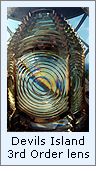 After numerous delays in Paris, the
Third Order lens and pedestal were finally delivered to the Detroit
depot in 1901, and the lens, District Lampist, a work party and the
materials needed for station repairs were loaded aboard the Amaranth,
and delivered to Devils Island on June 22. While the Lampist carefully
removed the pedestal and lens segments from their wooded crates and
hoisted them up to the lantern for assembly, the work party built
approximately 1,000 feet of tramway connecting the various station
buildings, cleared brush and timber to ensure that the new light would
be visible from all directions, constructed a woodshed and installed an
improved derrick. Work at the island continued until September 20, when
the brilliant new Third Order lens was exhibited from the new tower for
the first time. This new lens represented a remarkable improvement over
the old fourth order lens displayed from the timber tower. Equipped with
bulls eyes, the lens rotated about the lamp once every 20 seconds to
emit a white flash of 1.3 seconds duration followed by an eclipse of 8.7
seconds, a red flash of 1.3 seconds and an eclipse of 8.7 seconds. After numerous delays in Paris, the
Third Order lens and pedestal were finally delivered to the Detroit
depot in 1901, and the lens, District Lampist, a work party and the
materials needed for station repairs were loaded aboard the Amaranth,
and delivered to Devils Island on June 22. While the Lampist carefully
removed the pedestal and lens segments from their wooded crates and
hoisted them up to the lantern for assembly, the work party built
approximately 1,000 feet of tramway connecting the various station
buildings, cleared brush and timber to ensure that the new light would
be visible from all directions, constructed a woodshed and installed an
improved derrick. Work at the island continued until September 20, when
the brilliant new Third Order lens was exhibited from the new tower for
the first time. This new lens represented a remarkable improvement over
the old fourth order lens displayed from the timber tower. Equipped with
bulls eyes, the lens rotated about the lamp once every 20 seconds to
emit a white flash of 1.3 seconds duration followed by an eclipse of 8.7
seconds, a red flash of 1.3 seconds and an eclipse of 8.7 seconds.
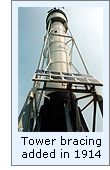 No longer serving any purpose, the
timber skeletal tower and lantern were dismantled in 1904, and the
materials placed in storage. 1907 saw the extension of the boat landing
and the construction of a 78-foot long rubble stone sea wall to protect
the shore in the area of the boat house. The keepers settled into the
daily routine for the next 14 years, with no major events of changes at
the station. In 1914, the station's illuminating apparatus was upgraded
from kerosene fuel to a more efficient oil vapor system with an increase
in output of the white flash to 45,000 candlepower and the red flash to
35,000 candlepower, and a resulting increase in the range of visibility
to 18 miles. Also in 1914, in order to correct a stability problem similar to
that previously encountered at the Sturgeon Bay Ship
Canal Light, the new tower was retrofitted with four vertical
columns connected by horizontal bracing, which provided additional
bracing to the watch room, and helped increase the tower's structural
rigidity. No longer serving any purpose, the
timber skeletal tower and lantern were dismantled in 1904, and the
materials placed in storage. 1907 saw the extension of the boat landing
and the construction of a 78-foot long rubble stone sea wall to protect
the shore in the area of the boat house. The keepers settled into the
daily routine for the next 14 years, with no major events of changes at
the station. In 1914, the station's illuminating apparatus was upgraded
from kerosene fuel to a more efficient oil vapor system with an increase
in output of the white flash to 45,000 candlepower and the red flash to
35,000 candlepower, and a resulting increase in the range of visibility
to 18 miles. Also in 1914, in order to correct a stability problem similar to
that previously encountered at the Sturgeon Bay Ship
Canal Light, the new tower was retrofitted with four vertical
columns connected by horizontal bracing, which provided additional
bracing to the watch room, and helped increase the tower's structural
rigidity.
As part of a network of stations being
installed around the Great Lakes, Devils Island was outfitted with a
radiobeacon system in 1925, with the system placed into operation on
October 30. A transmitter was installed in one of the station buildings
and connected to an antenna located 220 feet from the tower. The station
transmitted at a frequency of 286 kilocycles and transmitted repeated
groups of three Morse Code dashes every 60 seconds followed by 60
seconds of silence during periods of thick weather. Additionally, the
transmitter was activated every morning and evening for a half hour test
between 5.00 and 5.30 and 11.00 and 11.30.
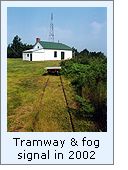 The following year saw the removal of
the 10-inch steam whistle from the fog signal building and the
installation of a much improved air-operated diaphone
fog signal. The station was equipped with a diesel-powered electrical
generator in 1928, with a resulting increase in the intensity of the
light to 300,000 candlepower for the white flash and 180,000 candlepower
for the red flash. Also at this time, the flash characteristic was
changed to a white flash of 0.6 seconds followed by an eclipse of 9.4
seconds, red flash of 0.6 seconds and a final eclipse of 9.4 seconds.
Since the stations in the Apostles chain closed down every December, the
generator was winterized before the keeper's departed and thus the light
was simultaneously extinguished. However there was always the
possibility that a few straggling vessels would be making their way
through the thickening ice without the benefit of the Devils island
light as a guide. To serve these late season vessels, that same year the
lantern was equipped with a 200 mm, 130 candlepower acetylene-powered
winter light. With a large tank of acetylene located close to the base
of the tower, the gas was piped into the lantern and automatically
turned on and off every day by means of a sun valve, which used a
bimetal mechanism which expanded and contracted in reaction to the
difference in day and nighttime temperatures, automatically switching
the flow of gas to the lamp. The following year saw the removal of
the 10-inch steam whistle from the fog signal building and the
installation of a much improved air-operated diaphone
fog signal. The station was equipped with a diesel-powered electrical
generator in 1928, with a resulting increase in the intensity of the
light to 300,000 candlepower for the white flash and 180,000 candlepower
for the red flash. Also at this time, the flash characteristic was
changed to a white flash of 0.6 seconds followed by an eclipse of 9.4
seconds, red flash of 0.6 seconds and a final eclipse of 9.4 seconds.
Since the stations in the Apostles chain closed down every December, the
generator was winterized before the keeper's departed and thus the light
was simultaneously extinguished. However there was always the
possibility that a few straggling vessels would be making their way
through the thickening ice without the benefit of the Devils island
light as a guide. To serve these late season vessels, that same year the
lantern was equipped with a 200 mm, 130 candlepower acetylene-powered
winter light. With a large tank of acetylene located close to the base
of the tower, the gas was piped into the lantern and automatically
turned on and off every day by means of a sun valve, which used a
bimetal mechanism which expanded and contracted in reaction to the
difference in day and nighttime temperatures, automatically switching
the flow of gas to the lamp.
 With the Coast Guard's assumption of
responsibility for the nation's aids to navigation in 1939, five-man
coast guard crews were assigned to the island to tend the equipment.
After President Nixon signed legislation creating the Apostle Islands
National Lakeshore on September 26, 1970, most of the islands in the
chain were incorporated into the National Park System. However, the
Coast Guard continued to maintained ownership of the lighthouse
reservations. As the other Apostles lighthouses were automated and their
crews removed through the 1970's, a crew still manned the Devils Island
Light station, using it as a base of operations to maintain and repair
the other lights in the island chain. Thus. in 1978 the Devils Island
Light became the last of the Apostle Lights to be automated through the
installation of a 12-volt solar-bulb within the Fresnel lens. With the Coast Guard's assumption of
responsibility for the nation's aids to navigation in 1939, five-man
coast guard crews were assigned to the island to tend the equipment.
After President Nixon signed legislation creating the Apostle Islands
National Lakeshore on September 26, 1970, most of the islands in the
chain were incorporated into the National Park System. However, the
Coast Guard continued to maintained ownership of the lighthouse
reservations. As the other Apostles lighthouses were automated and their
crews removed through the 1970's, a crew still manned the Devils Island
Light station, using it as a base of operations to maintain and repair
the other lights in the island chain. Thus. in 1978 the Devils Island
Light became the last of the Apostle Lights to be automated through the
installation of a 12-volt solar-bulb within the Fresnel lens.
In 1986, Congress passed legislation
transferring all lands within the Apostle Islands National Lakeshore
Park boundaries over to the NPS, and in a single stroke of the pen all
of the Coast Guard properties within the park were moved to NPS
ownership, and while the Coast Guard still maintained the right to
service the aids to navigation within the park, the NPS took ownership
of all of the former Lighthouse reservations and the structures therein.
 In order to protect the station's Third
Order lens from further deterioration or vandalism, the Coast Guard
disassembled the lens and removed both it and the cast iron pedestal
from the lantern in 1989, replacing it with a solar-powered acrylic 190
mm optic mounted on the gallery hand rail. The lens was shipped to
storage at the NPS headquarters in Bayfield. In 1992, the Apostle
Islands National Park determined that it would be fitting to restore the
lens and return it for permanent display in the lantern atop the tower
on Devils Island. Greg Byrne, an NPS conservator from Harpers Ferry,
West Virginia was contacted, and Greg arrived in Bayfield that summer to
restore the massive lens. The lens was carefully returned to its crates,
and on August 31, was loaded on a National Guard Chinook helicopter and
flown back to Devils Island, where NPS employees erected a hoist on the
tower gallery and with a tractor on the ground providing the pulling
power, carefully lifted the 600-pound components of the pedestal onto
the gallery and back into the lantern. With the pedestal reassembled in
place, the following day the lens sections were carefully hoisted to the
lantern and reassembled on the pedestal. In order to protect the station's Third
Order lens from further deterioration or vandalism, the Coast Guard
disassembled the lens and removed both it and the cast iron pedestal
from the lantern in 1989, replacing it with a solar-powered acrylic 190
mm optic mounted on the gallery hand rail. The lens was shipped to
storage at the NPS headquarters in Bayfield. In 1992, the Apostle
Islands National Park determined that it would be fitting to restore the
lens and return it for permanent display in the lantern atop the tower
on Devils Island. Greg Byrne, an NPS conservator from Harpers Ferry,
West Virginia was contacted, and Greg arrived in Bayfield that summer to
restore the massive lens. The lens was carefully returned to its crates,
and on August 31, was loaded on a National Guard Chinook helicopter and
flown back to Devils Island, where NPS employees erected a hoist on the
tower gallery and with a tractor on the ground providing the pulling
power, carefully lifted the 600-pound components of the pedestal onto
the gallery and back into the lantern. With the pedestal reassembled in
place, the following day the lens sections were carefully hoisted to the
lantern and reassembled on the pedestal.
While the
Vega VRB-25 optic mounted on the
gallery railing still serves as the light source for the station, the
Fresnel lens sits majestically in the lantern designed to hold it, a
befitting location for such a wonderful object. Visitors fortunate
enough to make landing on the island can climb the tower stairs and
enter the lantern to marvel at the jewel-like intricacy of the
century-old French lens.

Keepers of
this Light

Click here
to see a complete listing of all Devils Island Light keepers compiled by
Phyllis L. Tag of Great Lakes Lighthouse Research.

Seeing this Light

For five days in July, 2002, we were privileged to serve as NPS
volunteers, assisting Park Historian Bob Mackreth in documenting the
condition of all the Apostle Islands Lights. The weather was calm on our
visit to Devils Island, and the Government boat was thus able to tie-up
directly to the rocks near the station. After a short walk up the
overgrown trail to the top of the cliffs, the view of the expansive
cleared station and the two impressive dwellings was stunning. We
photographed the buildings in awe as we considered the daunting task it
must have been to unload, land and transport the building materials
needed for the station's construction. Wisconsin's famous biting flies
were omnipresent on the day of our visit, finding our white socks
particularly attractive, and able to bight right through them. After
climbing the tower, we were impressed by myriad slivers of rainbow light
on the tower floor as the sun, refracted through the Third Order lens.
Departing the island, the boat slowly motored around the northern point
of the island, and we could readily see see how deeply the sea caves
penetrate the island's shore, and the wafer thin upper layer of soil in
which the island's greenery has taken hold.

Finding this Light

While all of the Apostle Island Lights are open for visitation, a
private boat is needed to make landfall at Devil's Island for all but
two weeks of the year. While Apostle
Island Cruise Service offers daily trips around the islands, passing
close to the island for photography, it is only during the two weeks of
the annual Keeper of The Light festival
in September that they offer landings on Devils Island. 
Contact information
P.O. Box 691 - City Dock
Bayfield, WI 54814
Telephone: (800) 323-7619
Email: info@apostleisland.com
For information on the Keeper
Of The Light Celebration, contact:
PO Box 990 19 Front St.
Bayfield, WI 54814
Telephone: (800) 779-4487

Historical
references

 Annual reports of the lighthouse Board, various, 1853 - 1909 Annual reports of the lighthouse Board, various, 1853 - 1909
Annual reports of the Lighthouse Service, various, 1910 - 1953
Great Lakes Light Lists, various, 1861 - 1977
Annual reports of the Lake Carrier's Association, various, 1906 -
1940
Wisconsin Maritime History Association, website
Recent photograph courtesy of Dan Tomhave, and Ken & Barb Wardius.
Historic photographs courtesy of the USCG and NPS historians offices.
Email correspondence with Bob Mackreth NPS, various, January &
February 2002
Wisconsin Handbook, Thomas Huhti, Moon Travel Handbooks, 1997
Keeper listings for this light appear
courtesy of Great
Lakes Lighthouse Research
|
